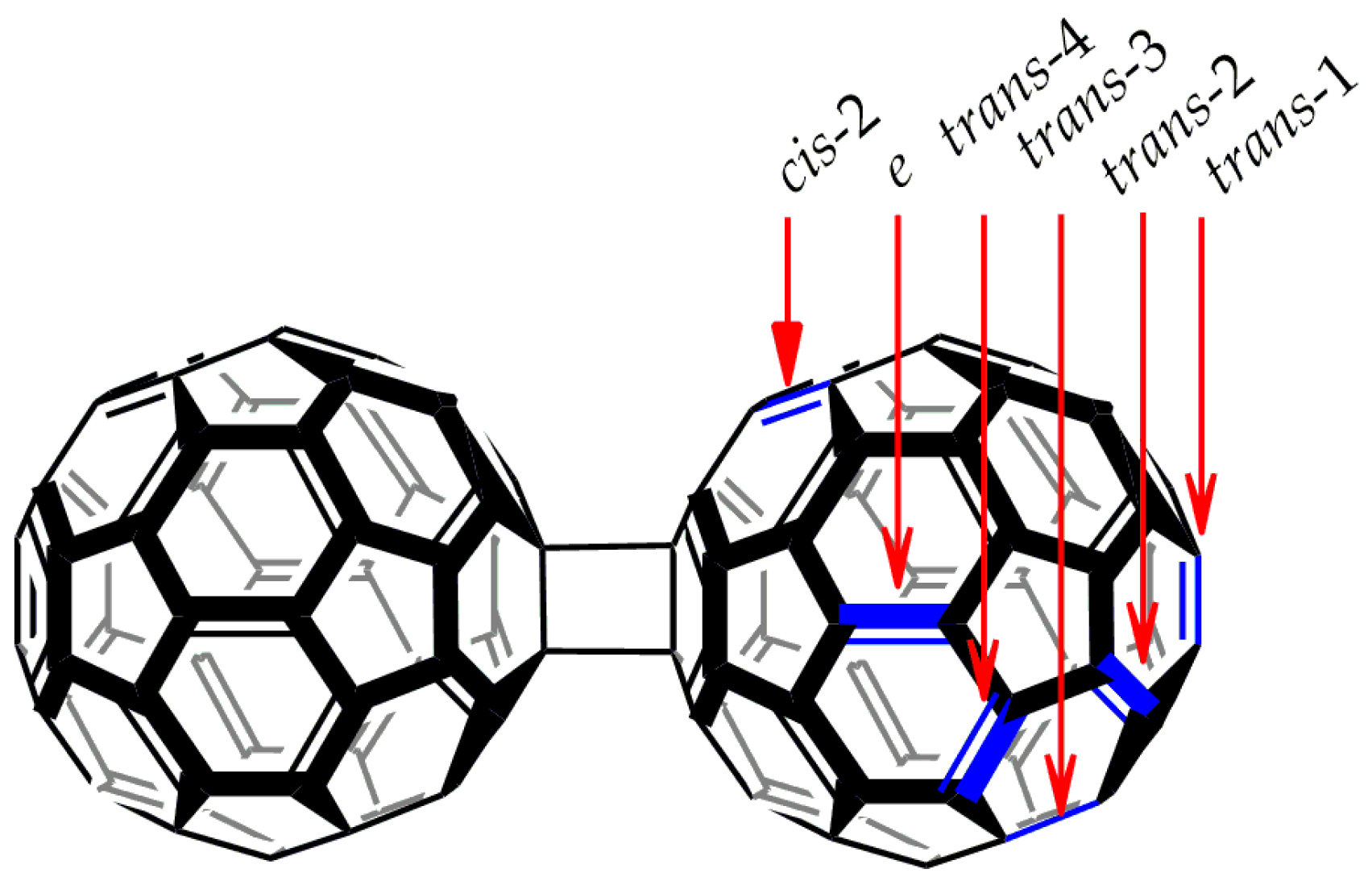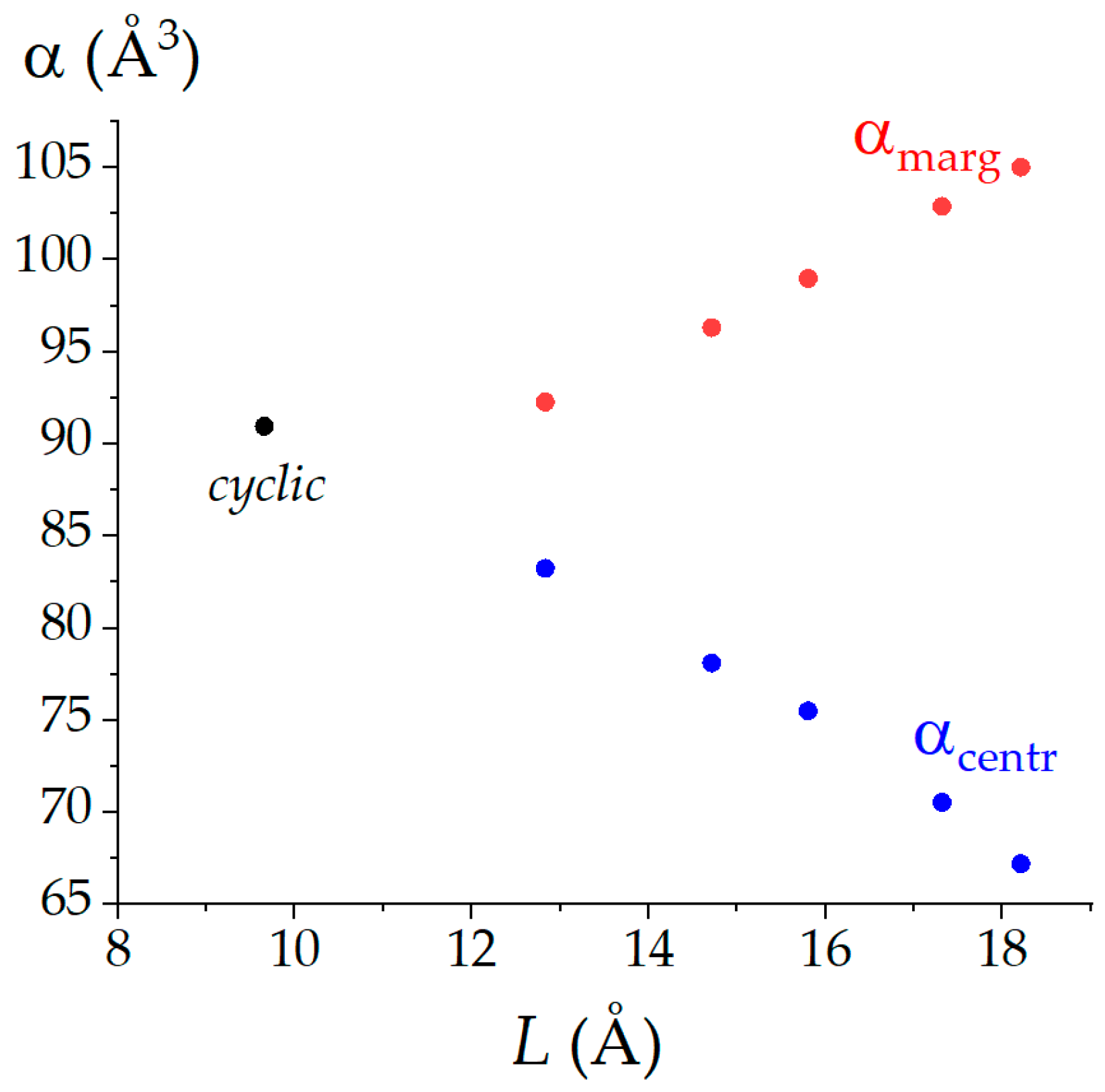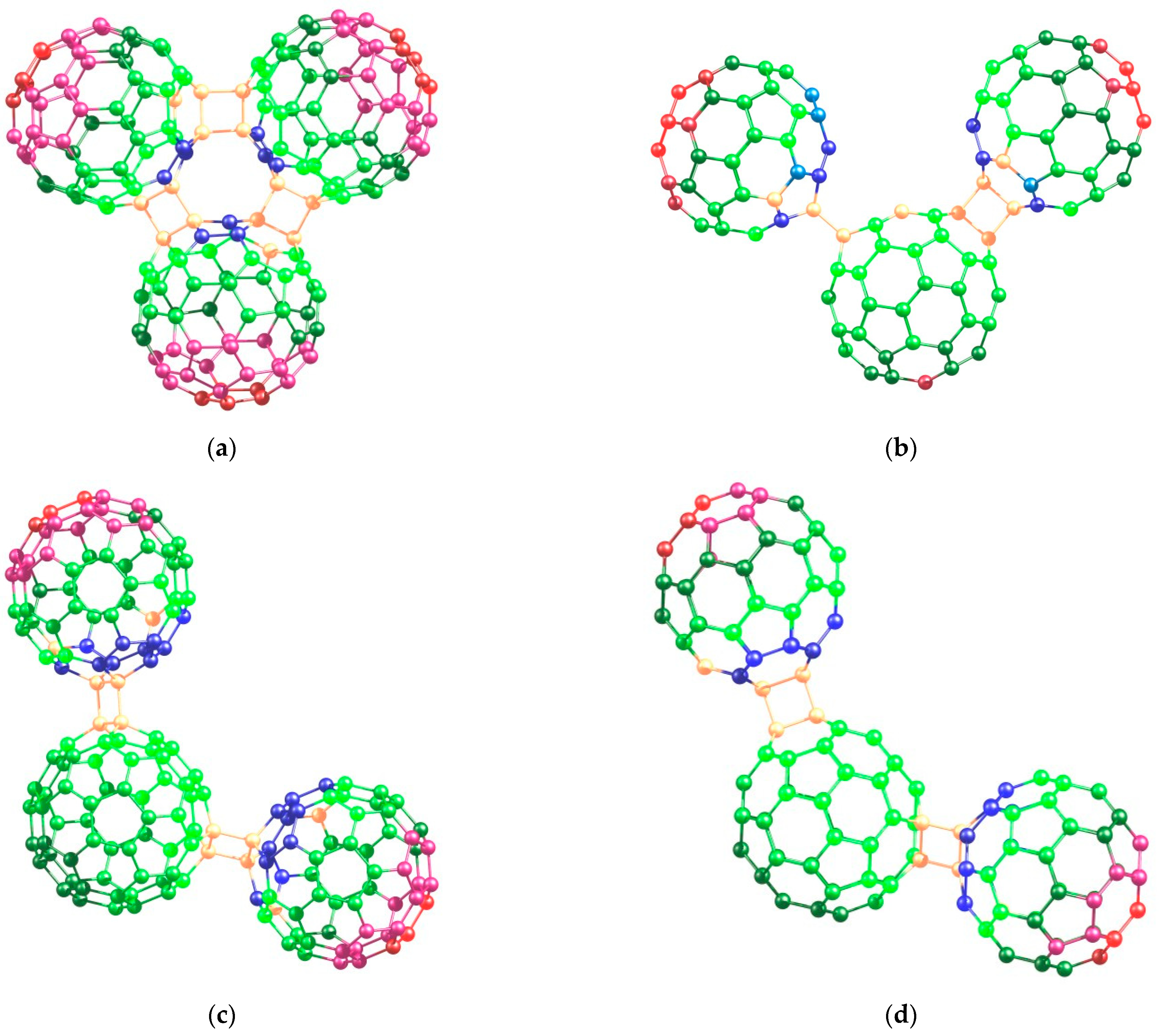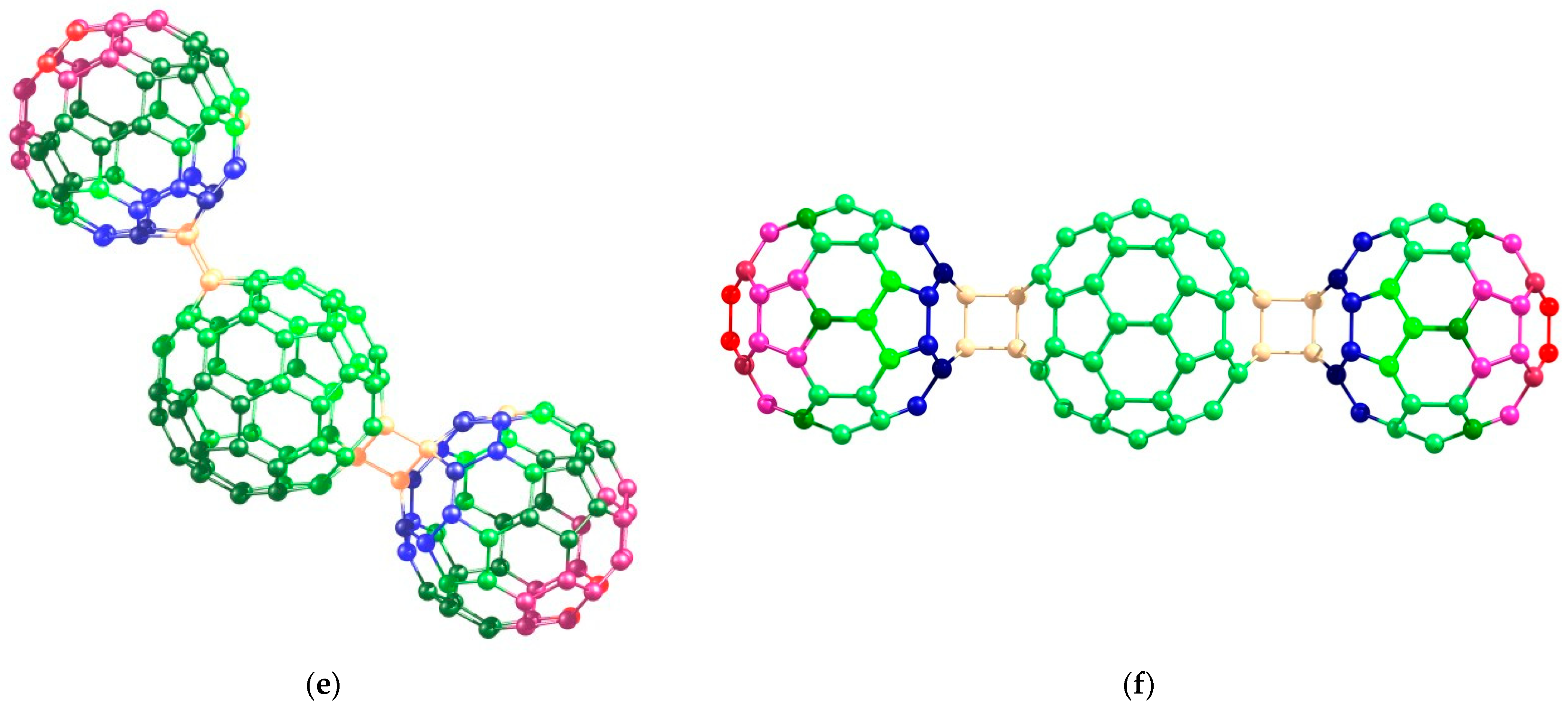Distributed Polarizability Model for Covalently Bonded Fullerene Nanoaggregates: Origins of Polarizability Exaltation
Abstract
1. Introduction
2. Computational Details
3. Results
4. Discussion
4.1. Relevance to the Experimental Data on the C60 Polarizability
4.2. Distributed Polarizability Model of (C60)3: The Responses of the Cores Differ
4.3. Distributed Polarizability Maps of (C60)3
4.4. Prospective: From Fundamental Properties to Nanoapplications
5. Conclusions
Supplementary Materials
Author Contributions
Funding
Institutional Review Board Statement
Informed Consent Statement
Data Availability Statement
Acknowledgments
Conflicts of Interest
References
- Segura, J.L.; Martin, N. [60] Fullerene dimers. Chem. Soc. Rev. 2000, 29, 13–25. [Google Scholar] [CrossRef]
- Komatsu, K.; Fujiwara, K.; Tanaka, T.; Murata, Y. The fullerene dimer C120 and related carbon allotropes. Carbon 2000, 38, 1529–1534. [Google Scholar] [CrossRef]
- Tukhbatullina, A.A.; Shepelevich, I.S.; Sabirov, D.S. Exaltation of polarizability as a common property of fullerene dimers with diverse intercage bridges. Fuller. Nanotub. Carbon Nanostruct. 2018, 26, 661–666. [Google Scholar] [CrossRef]
- Komatsu, K.; Wang, G.-W.; Murata, Y.; Tanaka, T.; Fujiwara, K.; Yamamoto, K.; Saunders, M. Mechanochemical synthesis and characterization of the fullerene dimer C120. J. Org. Chem. 1998, 63, 9358–9366. [Google Scholar] [CrossRef]
- Sabirov, D.S.; Terentyev, A.O.; Bulgakov, R.G. Polarizability of fullerene [2+2]-dimers: A DFT study. Phys. Chem. Chem. Phys. 2014, 16, 14594–14600. [Google Scholar] [CrossRef]
- Kunitake, M.; Uemura, S.; Ito, O.; Fujiwara, K.; Murata, Y.; Komatsu, K. Structural analysis of C60 trimers by direct observation with scanning tunneling microscopy. Angew. Chem. Int. Ed. 2002, 41, 969–972. [Google Scholar] [CrossRef]
- Sabirov, D.S. Polarizability of C60 fullerene dimer and oligomers: The unexpected enhancement and its use for rational design of fullerene-based nanostructures with adjustable properties. RSC Adv. 2013, 3, 19430–19439. [Google Scholar] [CrossRef]
- Komatsu, K.; Fujiwara, K.; Murata, Y. The mechanochemical synthesis and properties of the fullerene trimer C180. Chem. Lett. 2000, 29, 1016–1017. [Google Scholar] [CrossRef]
- Sabirov, D.S.; Ori, O.; Tukhbatullina, A.A.; Shepelevich, I.S. Covalently bonded fullerene nano-aggregates (C60)n: Digitalizing their energy–topology–symmetry. Symmetry 2021, 13, 1899. [Google Scholar] [CrossRef]
- Goedde, B.; Waiblinger, M.; Jakes, P.; Weiden, N.; Dinse, K.-P.; Weidinger, A. ‘Nitrogen doped’ C60 dimers (N@C60–C60). Chem. Phys. Lett. 2001, 334, 12–17. [Google Scholar] [CrossRef]
- Plant, S.R.; Jervic, M.; Morton, J.J.L.; Ardavan, A.; Khlobystov, A.N.; Briggs, G.A.D.; Porfyrakis, K. A two-step approach to the synthesis of N@C60 fullerene dimers for molecular qubits. Chem. Sci. 2013, 4, 2971–2975. [Google Scholar] [CrossRef]
- Ma, F.; Li, Z.-R.; Zhou, Z.-J.; Wu, D.; Li, Y.; Wang, Y.-F.; Li, Z.-S. Modulated nonlinear optical responses and charge transfer transition in endohedral fullerene dimers Na@C60C60@F with n-fold covalent bond (n = 1, 2, 5, and 6) and long range ion bond. J. Phys. Chem. C 2010, 114, 11242–11247. [Google Scholar] [CrossRef]
- Ohtsuki, T.; Masumoto, K.; Tanaka, T.; Komatsu, K. Formation of dimer, trimer, and tetramer of C60 and C70 by γ-ray, charged-particle irradiation, and their HPLC separation. Chem. Phys. Lett. 1999, 300, 661–666. [Google Scholar] [CrossRef]
- Kurokawa, S.; Yamamoto, D.; Hirashige, K.; Sakai, A. Possible formation of one-dimensional chains of C20 fullerenes observed by scanning tunneling microscopy. Appl. Phys. Express 2016, 9, 045102. [Google Scholar] [CrossRef]
- Zhechkov, L.; Heine, T.; Seifert, G. D5h C50 fullerene: A building block for oligomers and solids? J. Phys. Chem. A 2004, 108, 11733–11739. [Google Scholar] [CrossRef]
- Bonin, K.D.; Kresin, V.V. Electric-Dipole Polarizabilities of Atoms, Molecules, and Clusters; World Scientific: Singapore; River Edge, NJ, USA, 1997. [Google Scholar]
- Swart, M.; van Duijnen, P.T. Rapid determination of polarizability exaltation in fullerene-based nanostructures. J. Mater. Chem. 2015, 3, 23–25. [Google Scholar] [CrossRef]
- Jackson, K.; Yang, M.; Jellinek, J. Site-specific analysis of dielectric properties of finite systems. J. Phys. Chem. C 2007, 111, 17952–17960. [Google Scholar] [CrossRef]
- Marenich, A.V.; Cramer, C.J.; Truhlar, D.G. Reduced and quenched polarizabilities of interior atoms in molecules. Chem. Sci. 2013, 4, 2349–2356. [Google Scholar] [CrossRef]
- Tukhbatullina, A.A.; Khamitov, E.M.; Sabirov, D.S. Distributed polarizability of fullerene [2+1]-adducts C60X (n = 1 and 2) with symmetric addends X = CH2 and O: A fresh view on the effect of positional isomerism. Comput. Theor. Chem. 2019, 1149, 31–36. [Google Scholar] [CrossRef]
- Frisch, M.J.; Trucks, G.; Schlegel, H.B.; Scuseria, G.E. Gaussian 03, Revision D3.01; Gaussian Inc.: Wallingford, CT, USA, 2013. [Google Scholar]
- Hirshfeld, F.L. Bonded-atom fragments for describing molecular charge densities. Theor. Chim. Acta 1977, 44, 129–138. [Google Scholar] [CrossRef]
- Sabirov, D.S.; Terentyev, A.O.; Cataldo, F. Bisadducts of the C60 and C70 fullerenes with anthracene: Isomerism and DFT estimation of stability and polarizability. Comput. Theor. Chem. 2016, 1081, 44–48. [Google Scholar] [CrossRef]
- Sun, D.; Reed, C.A. Crystal eng ineering a linear polymer of C60 fullerene via supramolecular pre-organization. Chem. Commun. 2000, 2391. [Google Scholar] [CrossRef]
- Antoine, R.; Dugourd, P.; Rayane, D.; Benichou, E.; Broyer, M.; Chandezon, F.; Guet, C. Direct measurement of the electric polarizability of isolated C60 molecules. J. Chem. Phys. 1999, 110, 9771–9772. [Google Scholar] [CrossRef]
- Sohmen, E.; Fink, J.; Krätschmer, W. Electron energy-loss spectroscopy studies on C60 and C70 fullerite. Z. Phys. B Condens. Matter. 1992, 86, 87–92. [Google Scholar] [CrossRef]
- Ballard, A.; Bonin, K.; Louderback, J. Absolute measurement of the optical polarizability of C60. J. Chem. Phys. 2000, 113, 5732–5735. [Google Scholar] [CrossRef]
- Hackermüller, L.; Hornberger, K.; Gerlich, S.; Gring, M.; Ulbricht, H.; Arndt, M. Optical polarizabilities of large molecules measured in near-field interferometry. Appl. Phys. 2007, 89, 469–473. [Google Scholar] [CrossRef]
- Berninger, M.; Stefanov, A.; Deachapunya, S.; Arndt, M. Polarizability measurements of a molecule via a near-field matter-wave interferometer. Phys. Rev. A 2007, 76, 013607. [Google Scholar] [CrossRef]
- Hornberger, K.; Gerlich, S.; Ulbricht, H.; Hackermüller, L.; Nimmrichter, S.; Goldt, I.V.; Boltalina, O.; Arndt, M. Theory and experimental verification of Kapitza–Dirac–Talbot–Lau interferometry. New J. Phys. 2009, 11, 043032. [Google Scholar] [CrossRef]
- Munn, R.W.; Petelenz, P. Mechanism for effective polarizability enhancement in molecular crystals: C60. Chem. Phys. Lett. 2004, 392, 7–10. [Google Scholar] [CrossRef]
- Munn, R.; Malagoli, M.; Panhuis, M.I.H. Environmental effects on molecular response in materials for non-linear optics. Synth. Met. 2000, 109, 29–32. [Google Scholar] [CrossRef]
- Pankratyev, E.Y.; Tukhbatullina, A.A.; Sabirov, D.S. Dipole polarizability, structure, and stability of [2+2]-linked fullerene nanostructures (C60)n (n ≤ 7). Phys. E 2017, 86, 237–242. [Google Scholar] [CrossRef]
- Broyer, M.; Antoine, R.; Benichou, E.; Compagnon, I.; Dugourd, P.; Rayane, D. Structure of nano-objects through polarizability and dipole measurements. Comptes Rendus Phys. 2002, 3, 301–317. [Google Scholar] [CrossRef]
- Sabirov, D.S.; Ōsawa, E. Dipole polarizability of nanodiamonds and related structures. Diamond Relat. Mater. 2015, 55, 64–69. [Google Scholar] [CrossRef]
- Ueno, H.; Ōsawa, S.; Ōsawa, E.; Takeuchi, K. Stone-Wales rearrangement pathways from the hinge-opened [2 + 2] C60 dimer to Ipr C120 fullerenes. Vibrational analysis of intermediates. Fuller. Sci. Technol. 1998, 6, 319–338. [Google Scholar] [CrossRef]
- Takashima, A.; Nishii, T.; Onoe, J. Formation process and electron-beam incident energy dependence of one-dimensional uneven peanut-shaped C60 polymer studied using in situ high-resolution infrared spectroscopy and density-functional calculations. J. Phys. D Appl. Phys. 2012, 45, 485302. [Google Scholar] [CrossRef]
- Wang, G.; Li, Y.; Huang, Y. Structures and electronic properties of peanut-shaped dimers and carbon nanotubes. J. Phys. Chem. 2005, 109, 10957–10961. [Google Scholar] [CrossRef]
- Noda, Y.; Ono, S.; Ohno, K. Geometry dependence of electronic and energetic properties of one-dimensional peanut-shaped fullerene polymers. J. Phys. Chem. A 2015, 119, 3048–3055. [Google Scholar] [CrossRef]
- Musil, F.; Grisafi, A.; Bartók, A.P.; Ortner, C.; Csányi, G.; Ceriotti, M. Physics-inspired structural representations for molecules and materials. Chem. Rev. 2021, 121, 9759–9815. [Google Scholar] [CrossRef]
- Huber, S.E.; Gatchell, M.; Zettergren, H.; Mauracher, A. A precedent of van der Waals interactions outmatching Coulomb explosion. Carbon 2016, 109, 843–850. [Google Scholar] [CrossRef]
- Mezour, M.A.; Voznyy, O.; Sargent, E.H.; Lennox, R.B.; Perepichka, D.F. Controlling C60 Organization through Dipole-Induced Band Alignment at Self-Assembled Monolayer Interfaces. Chem. Mater. 2016, 28, 8322–8329. [Google Scholar] [CrossRef]
- Hong, I.-H.; Gao, C.-J. Large area self-ordered parallel C60 molecular nanowire arrays on Si(110) surfaces. Carbon 2016, 107, 925–932. [Google Scholar] [CrossRef]
- López-Andarias, J.; Bauzá, A.; Sakai, N.; Frontera, A.; Matile, S. Remote control of anion-π catalysis on fullerene-centered catalytic triads. Angew. Chem. 2018, 130, 11049–11053. [Google Scholar] [CrossRef]
- Bornhof, A.; Vázquez-Nakagawa, M.; Rodríguez-Pérez, L.; Angeles Herranz, M.; Sakai, N.; Martín, N.; Matile, S.; López-Andarias, J. Anion−π catalysis on carbon nanotubes. Angew. Chem. Int. Ed. 2019, 58, 16097–16100. [Google Scholar] [CrossRef] [PubMed]
- Shirai, Y.; Osgood, A.J.; Zhao, Y.; Kelly, K.F.; Tour, J.M. Directional control in thermally driven single-molecule nanocars. Nano Lett. 2005, 5, 2330–2334. [Google Scholar] [CrossRef]
- Akimov, A.V.; Kolomeisky, A.B. Unidirectional rolling motion of nanocars induced by electric field. J. Phys. Chem. 2012, 116, 22595–22601. [Google Scholar] [CrossRef]
- Dorner-Reisel, A.; Ritter, U.; Moje, J.; Freiberger, E.; Scharff, P. Effect of fullerene C60 thermal and tribomechanical loading on Raman signals. Diamond Relat. Mater. 2022, 126, 109036. [Google Scholar] [CrossRef]
- Liu, D.; Lungerich, D.; Nakamuro, T.; Harano, K.; Nakamura, E. Excited state modulation of C70 dimerization in a carbon nanotube under a variable electron acceleration voltage. Micron 2022, 160, 103316. [Google Scholar] [CrossRef] [PubMed]
- Weippert, J.; Hohmann, L.; Strelnikov, D.; Weis, P.; Pop, M.L.; Böttcher, A.; Kappes, M.M. Desorption of fullerene dimers upon heating non-IPR fullerene films on HOPG. J. Phys. Chem. 2019, 123, 5721–5730. [Google Scholar] [CrossRef]
- BinSabt, M.H.; Al-Matar, H.M.; Balch, A.L.; Shalaby, M.A. Synthesis and electrochemistry of novel dumbbell-shaped bis-pyrazolino [60] fullerene derivatives formed using microwave radiation. ACS Omega 2021, 6, 20321–20330. [Google Scholar] [CrossRef]







| Molecule | Mean Polarizability, α (Å3) | Polarizability Exaltation, Δα (Å3) 1 | Central Core Contribution (Å3) | Marginal Core Contribution (Å3) | Remoteness of Marginal Cores, L (Å) 2 |
|---|---|---|---|---|---|
| (C60)2 | 174.54 | 13.94 | n/a | 87.27 | 9.710 |
| Cyclic (C60)3 | 272.90 | 32.00 | 90.97 3 | 90.97 3 | 9.655 |
| e-(C60)3 | 267.83 | 26.93 | 83.26 | 92.28 | 12.833 |
| trans-4-(C60)3 | 270.77 | 29.87 | 78.13 | 96.32 | 14.714 |
| trans-3-(C60)3 | 273.49 | 32.60 | 75.52 | 98.99 | 15.804 |
| trans-2-(C60)3 | 276.38 | 35.48 | 70.56 | 102.91 | 17.319 |
| trans-1-(C60)3 | 277.29 | 36.39 | 67.22 | 105.03 | 18.210 |
Publisher’s Note: MDPI stays neutral with regard to jurisdictional claims in published maps and institutional affiliations. |
© 2022 by the authors. Licensee MDPI, Basel, Switzerland. This article is an open access article distributed under the terms and conditions of the Creative Commons Attribution (CC BY) license (https://creativecommons.org/licenses/by/4.0/).
Share and Cite
Sabirov, D.S.; Tukhbatullina, A.A. Distributed Polarizability Model for Covalently Bonded Fullerene Nanoaggregates: Origins of Polarizability Exaltation. Nanomaterials 2022, 12, 4404. https://doi.org/10.3390/nano12244404
Sabirov DS, Tukhbatullina AA. Distributed Polarizability Model for Covalently Bonded Fullerene Nanoaggregates: Origins of Polarizability Exaltation. Nanomaterials. 2022; 12(24):4404. https://doi.org/10.3390/nano12244404
Chicago/Turabian StyleSabirov, Denis Sh., and Alina A. Tukhbatullina. 2022. "Distributed Polarizability Model for Covalently Bonded Fullerene Nanoaggregates: Origins of Polarizability Exaltation" Nanomaterials 12, no. 24: 4404. https://doi.org/10.3390/nano12244404
APA StyleSabirov, D. S., & Tukhbatullina, A. A. (2022). Distributed Polarizability Model for Covalently Bonded Fullerene Nanoaggregates: Origins of Polarizability Exaltation. Nanomaterials, 12(24), 4404. https://doi.org/10.3390/nano12244404








